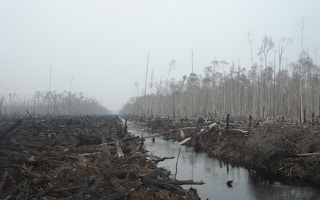Official documentation submitted by Indonesia to the UN climate talks in Paris this week dramatically underestimates deforestation and emissions in the archipelago, according to an analysis by Greenpeace.
However, not everyone agrees with Greenpeace’s assessment.
The documentation’s omissions include 10 million hectares of deforestation, millions of hectares of peatland degradation and emissions from the annual farm and plantation fires, threatening to undermine Indonesia’s prospects for receiving international assistance for peatland protection and REDD+ schemes, according to the NGO.
“The people of Indonesia deserve to know the truth about how much forest and peatland has been destroyed,” Greenpeace Indonesia forest campaigner Annisa Rahmawati said. “Only from a truthful foundation can we build a solid climate plan for Indonesia.”
The documentation, known as the Forest Reference Emissions Levels (FREL), constitutes the government’s official declaration of baseline emissions.
Among the “serious issues, omissions and errors” the FREL is said to contain is a discrepancy between the unpublished data and maps underpinning many of its figures, and data and maps already in the public domain.
For example, the FREL reports 113 million hectares of forest cover in 1990, even though previous forestry ministry figures showed 123 million hectares of forest that year.
Also, the maps FREL uses include only 14.9 million hectares of peatland, whereas Greenpeace says the most reliable figure for Indonesia’s peat coverage is 22 million hectares. That figure comes from a map devised by Wetlands International in partnership with the government in the early 2000s.
“In order for official reports such as the FREL … to be credible, the underlying maps and the justifications for changes in data on which Indonesia’s international climate contribution and pledges are based need to be available for public scrutiny,” Greenpeace said in a statement. “This is necessary in the interests of transparency and accountability to Indonesians and to the international community.”
The emissions from annual wildfires over the 1990-2012 baseline period have also been left off the accounts. As this year’s crisis shows, fire emissions can form a significant share of Indonesia’s total greenhouse gas emissions. On 47 of the 74 days to October 28, Indonesia’s fire emissions alone are estimated to have surpassed those of the entire US economy.
According to the FREL, emissions from the fires were omitted because of the “complicated and highly uncertain” nature of calculating them, and because the figures will be factored into peat degradation figures over the long term.
But Greenpeace points out that the FREL could use an estimate of the figure, as does Indonesia’s National Action Plan on GHG Reduction.
“It is nonsensical to calculate Indonesia’s emissions while excluding its biggest source: the fires that have destroyed millions of hectares of Indonesia’s forests and peatlands,” Annisa said.
Further reducing emissions figures is what appears to be a basic mathematical error in the calculation of average annual deforestation from 1990-2012.
To obtain the average, the FREL divides the 22-year period into smaller periods of varying lengths. Then it takes the annual average for each period and averages them all together. But it fails to weight the smaller periods’ averages for the periods’ different lengths, skewing the final result and the corresponding emissions figures. While the FREL puts average annual deforestation at 918,678 hectares, Greenpeace has it at 969,968 hectares.
The ministry did not reply to a request for comment.
However not everyone agrees with Greenpeace’s c of the FREL.
“This report seems to suggest that the Indonesian government is lying about or trying to hide the biggest source of emissions from its own people and the UNFCCC – emissions from peat fires and draining,” Michael Wolosin of Climate Advisors told Mongabay. “This simply is not true.”
“Indonesia included these emissions in their GHG reporting to the UNFCCC, and promised to update the estimates in its next GHG report to the UNFCCC,” he explained.
“The purpose of a Forest Reference Emission Level (FREL) is to establish a baseline for REDD+ funding – and the Indonesian government should be applauded, not berated, for leaving out peat emissions until they are confident in the estimates. By doing so, it is true that they may reduce international finance flows to Indonesia for REDD+ in the near term – but they also build trust in the global REDD+ system by avoiding any potential ‘hot air’. This is the kind of careful conservatism that Greenpeace should appreciate.”










